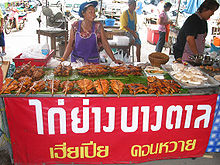Kai yang
This article includes a list of references, related reading, or external links, but its sources remain unclear because it lacks inline citations. (February 2013) |
 Kai yang at the old market of Don Wai, Nakhon Pathom | |
| Region or state | Southeast Asia |
|---|---|
| Associated cuisine | Lao, Thai |


Kai yang or gai yang (Thai: ไก่ย่าง, pronounced [kàj jâːŋ], lit. 'grilled chicken'), also known as kai ping or gai ping (Thai: ไก่ปิ้ง), or pīng kai (Lao: ປີ້ງໄກ່, [pîŋ kāj]), is a Lao dish originating in Laos, but it is now commonly eaten throughout the whole of Thailand.[citation needed] The dish is a standard staple of street markets and readily available at all times. Being a typical Laotian dish, it is often paired with green papaya salad and sticky rice (Thai/Isan: ข้าวเหนียว, pronounced [kʰâːw nǐa̯w]; Lao: ເຂົ້າໜຽວ or eaten with sticky rice in bamboo (khao lam in Lao). It is also eaten with raw vegetables, and often dipped in spicy sauces such as Laotian jaew bong.[citation needed]
In Thailand, there are also many famous Thai Muslim varieties of kai yang which are not of Lao origin at all, but more akin to the grilled chicken from Malaysia.[citation needed]
Names[edit]
The Laotian name for the dish is pīng kai (ປີ້ງໄກ່) and means "roast chicken". In Laotian restaurants in the West, it is known as "Laotian barbecued chicken" or "ping gai". The Thai and Isaan term is usually spelled ไก่ย่าง (kai yang; Isan: [kàj ɲâːŋ]), although ปิ้งไก่ (ping kai), a Thai letter rendering of the Laotian name, would be understood in Isan and in most of Thailand as well although to Thai ears it would sound a bit quaint, due to the slight grammatical difference between Thai and Laotian. Thais would put kai before ping rather than the other way round. In the West, where this dish often features on the menu of Thai restaurants, it is either known by its Thai name kai yang or as "Thai barbecued chicken".[citation needed]
Ingredients and preparation[edit]
A whole chicken is often halved and pounded flat. It is marinated and then grilled over a low heat on a charcoal flame for a long time, but is not cooked to be burnt or dry. The marinade typically includes fish sauce, garlic, turmeric, coriander root (cilantro), and white pepper. Many variations exist, and it is also quite common to find black soy sauce, hoisin sauce, shallots, leaves and seeds of coriander, lemongrass, chilis, ginger, vinegar, palm sugar, and MSG.[citation needed]
See also[edit]
References[edit]
- Tan, Terry. (2007). The Thai Table: A Celebration of Culinary Treasures. Marshall Cavendish. ISBN 981-261-442-7
- Brissenden, Rosemary. (2007). Southeast Asian food: Classic and Modern Dishes from Indonesia, Malaysia, Tuttle Publishing. ISBN 0-7946-0488-9
- McDermoot, Nancie. (1992). Real Thai: The Best of Thailand's Regional Cooking. Chronicle Books. ISBN 0-8118-0017-2

